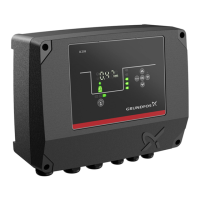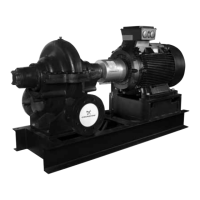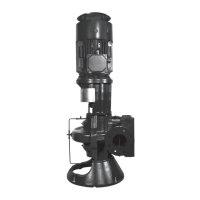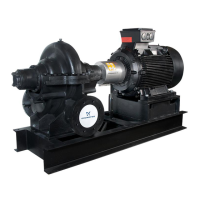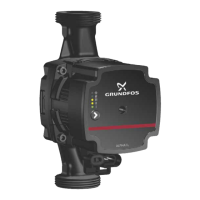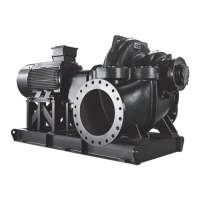3.2.1 Lifting the product
WARNING
Crushing hazard
Death or serious personal injury
‐ Handling must be performed by
qualified persons.
‐ When unloading the pump, lift equally
at four or more points on the base
frame. Do not lift by the motor or by the
pump. Do not lift by the flanges or by
the eyebolts on the motor.
Lift the pump by means of nylon straps and shackles.
TM068170
How to lift and handle the LS pumps
TM040380
How to lift and handle the LS bare shaft pumps
3.2.2 Foundation
We recommend that you install the pump on a
concrete foundation, which is heavy enough to
provide permanent and rigid support for the entire
pump. The foundation must be capable of absorbing
any vibration, normal strain or shock. We recommend
that the weight of the concrete foundation is 3 times
the weight of the complete pump unit. For specific
requirements, consult the contractor, engineer, or
established industry standards.
In installations where silent operation is particularly
important, we recommend a foundation that is up to 5
times as heavy as the complete pump unit.
3.2.3 Vibration dampers
Vibration dampers may be required to prevent pump
vibrations from being transmitted to the building or the
pipes. In order to select the right type of vibration
damper, you need this information:
• Forces transmitted through the damper.
• Motor speed. Take the motor speed into account
in the case of speed control.
• Desired dampening in %. The recommended
value is 70 %.
The choice of vibration dampers differs from
installation to installation. In certain cases a wrong
damper may increase the vibration level. Vibration
dampers must therefore be sized by the supplier of
the vibration dampers.
3.2.4 Expansion joints
Expansion joints provide these advantages:
• absorption of thermal expansion and contraction
of pipes caused by variations in liquid temperature
• reduction of mechanical influences in connection
with pressure surges in the pipes
• isolation of structure-borne noise in the pipes
(only rubber bellows expansion joints).
Do not fit expansion joints to make up for
inaccuracies in the pipes, such as centre
displacement or misalignment of flanges.
Fit the expansion joints at a minimum distance of 2
pipe diameters (DN) away from the pump flange on
the inlet side. This prevents turbulence in the joints,
thus ensuring optimum inlet conditions and minimum
pressure drop on the outlet side.
At flow velocities greater than 2.4 m/s, we
recommend that you fit larger expansion joints
matching the pipes.
7
English (GB)
